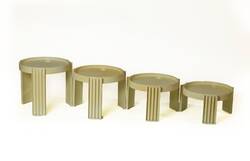Further Media
In ways similar to the Loos Tower to your right, the vases by Romina Gris on the display cabinet opposite or Sam Jacob’s scarf right next to it, this object underlines the unabated appeal of the classical orders for modernist design. Only at second glance does it become clear that the fluted column stump is a group of tables inserted into one another; once the four tables of different heights are stacked on top of one another, the column form becomes more clearly recognizable. It was designed by Gianfranco Frattini (1926-2004), one of the leading Italian architects and designers of the 1950s and 1960s.
In 1954, Frattini’s fruitful collaboration began with the famous Milan-based furniture manufacturer Cassina, with whom Le Corbusier, Gerrit Rietveld and Frank Lloyd Wright were also associated. Founded in 1927 by the brothers Cesare and Umberto Cassina, the manufactory initially specialised in custom-made interiors of the highest quality. It was only in the course of the 1950s, and due to increased demand, that the company made the transition to mass-produced items for a wider range of buyers. The design for the award-winning Marema table group dates back to 1967. It is still successfully reproduced today thanks to licensing agreements. In the meantime, however, Cassina has changed ownership, now belonging to Poltrona Frau, which has been controlled by the American Haworth Group since 2014. Poltrona Frau also documents the transition from the production of high-quality luxury furniture to industrial design through its own company history.
The hallmark of this transition, which can be experienced by taking a tour of the Kaiserzimmer, is the material employed. Precious woods and elaborately worked surfaces, as can still be seen in the first rooms, are increasingly being replaced by cheaper alternatives, in this case plastic. Similar to a column of an acntual ancient temple, the table set is also exposed to environmental influences that contribute to changes in appearance, in this case the noticeable yellowing and darkening. The original colour would have been even closer to marble or glazed ceramic.
Text: Alexander Röstel
